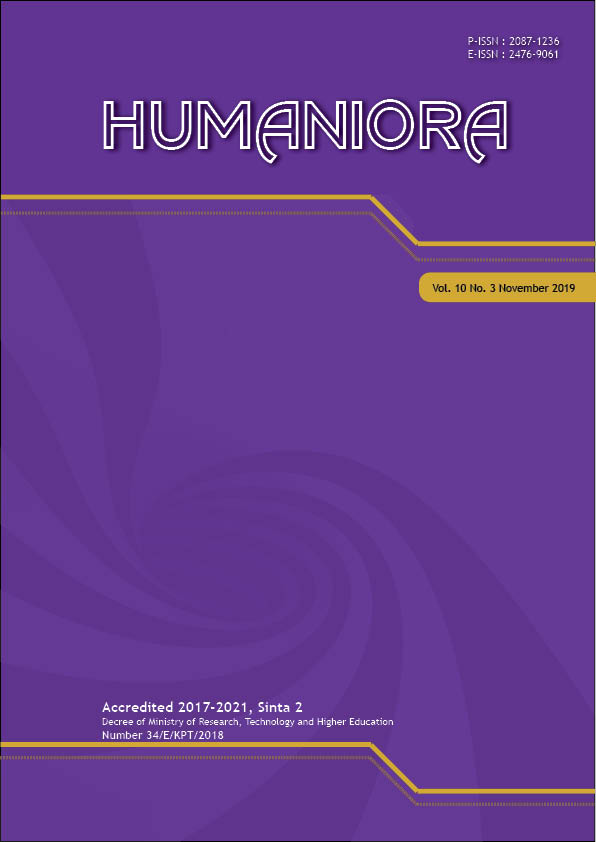Conflict Dynamic Framework: Religious Conflict Issues in Special Region of Yogyakarta
DOI:
https://doi.org/10.21512/humaniora.v10i3.6006Keywords:
conflict dynamic framework, religious conflict issuesAbstract
The researcher analyzed the conflict dynamic framework of religious conflict issues in the Special Region of Yogyakarta in 2014-2017. The research used qualitative descriptive research. Data collection techniques were primary data through interviews, observations, and secondary data through literature studies. Data analysis included data reduction, presentation, and verification. The results show that the conflict escalation degree in these past three years commonly is at the mass mobilization. Public-influencing religious and social figures successfully de-escalate it. Moreover, structural factors are triggered by education and policy of house of worship building, religious preaching, and exclusiveness. Those are also accelerated by society’s aggressiveness. Actors of conflict, in this case, are probably mass organizations and migrant communities. The related government agencies to resolve the conflict, and active participation from religious leaders, public figures, police, military, Ministry of Religious Affairs, Ministry of Law and Human Rights, Komisi Pemilihan Umum (KPU - General Elections Commission of Indonesia), and Badan Pengawas Pemilihan Umum (Bawaslu - Election Supervisory Board of Indonesia) are proven to have capacity to settle the issue.
References
Badan Pusat Statistik Provinsi Daerah Istimewa Yogyakarta. (2018). Statistik daerah provinsi Daerah Istimewa Yogyakarta 2018. Yogyakarta: Badan Pusat Statistik Provinsi Daerah Istimewa Yogyakarta.
Barwiński, M. (2019). Geographical, historical and political conditions of ongoing and potential ethnic conflicts in Central and Eastern Europe. European Spatial Research and Policy, 26(1), 149−173.
Bhandari, C. (2019). Social Dialogue: A Tool of Social Reintegration and Post-Conflict Peacebuilding in Nepal. Asian Journal of Peacebuilding, 7(1), 143−160.
BPS Provinsi D. I. Yogyakarta. (2015). Provinsi Daerah Istimewa Yogyakarta (Dalam Angka Daerah Istimewa Yogyakarta Province in Figures). Yogyakarta: BPS Provinsi D.I. Yogyakarta.
DuBois, B., & Miley, K. K. (1992). Social work: An empowering profession. Boston: Allyn and Bacon.
ELSAM. (2015). UU Nomor 7 tahun 2012 Tentang Penanganan Konflik Sosial. Retrieved from https://referensi.elsam.or.id/2015/04/uu-nomor-7-tahun-2012-tentang-penanganan-konflik-sosial/
Hasani, K., Boroujerdi, S. S., Sheikhesmaeili, S., & Aeini, T. (2014). Identity of organizational conflict framework: Evaluating model factors based on demographic characteristics in Iran. Journal of Industrial Engineering and Management (JIEM), 7(5), 1013−1036.
Iqbal, M. (2007). Analisis peran pemangku kepentingan dan implementasinya dalam pembangunan pertanian. Jurnal Litbang Pertanian, 26(3), 89−99.
Kachuyevski, A., & Olesker, R. (2014). Divided societies and identity boundaries: A conflict analysis framework. International Journal of Conflict Management, 25(3), 304−321.
Kusumadewi, A. (2016). Yogyakarta, kota yang makin tidak toleran. Retrieved from https://www.cnnindonesia.com/nasional/20160808211440-20-150068/yogyakarta-kota-yang-makin-tak-toleran.
Lang, M. K. (2019). Inter-ethnic conflict management and prevention in Cameroon’s Northwest: Assessing the role of the justice and peace commission of the Catholic Archdiocese of Bamenda. Asian Journal of Peacebuilding, 7(1), 125−142.
Malik, I. (2003). Mematahkan kekerasan dengan semangat Bakubae. Jakarta: YAPPIKA.
Malik, I. (2008). Pembangunan perdamaian & pencegahan konflik: Manual pelatihan. Jakarta: Canadian International Development Agency bermitra dengan Transparency International Indonesia.
Malik, I. (2017). Resolusi konflik: Jembatan perdamaian. Jakarta: Penerbit Buku Kompas.
Miles, M. B., Huberman, A. M., & Saldaña, J. (2014). Qualitative data analysis: A methods sourcebook (3rd Ed.). USA: SAGE Publications.
Nurdin, A. A., Jamaludin, A. N., Supriatna, E., & Kustana. (2019). The dynamic of religious life: A study of conflict and integration of Ahmadiyah in Garut, Tasikmalaya and Kuningan, West Java. Komunitas: International Journal of Indonesian Society and Culture, 11(1), 77−88.
Odoemene, A. (2012). Oiling the frictions in sociopolitical conflicts: Faith-based Institutional leadership of the JDPC in Grassroots Peacemaking in Nigeria. African Conflict and Peace Building Review, 2(2), 51−76.
Ratner, B. D., Meinzen-Dick, R., May, C., & Haglund, E. (2013). Resource conflict, collective action, and resilience: An analytical framework. International Journal of the Commons, 7(1), 183−208.
Siregar, C. (2016). Pluralism and religious tolerance in Indonesia: An ethical-theological review based on Christian faith perspectives. Humaniora, 7(3), 349−358.
Sugiyono. (2011). Metode penelitian administrasi. Bandung: Alfabeta.
Sumartias, S., & Rahmat, A. (2013). Faktor-faktor yang Mempengaruhi konflik sosial. Jurnal Penelitian Komunikasi, 16(1), 13−20.
Sunu, I. G. K. A., Sanjaya, D. B., & Sugiartha, W. (2014). Harmonisasi, integrasi desa pakraman dengan desa dinas yang multietnik dan multiagama menghadapi pergeseran, pelestarian, dan konflik di Bali. Jurnal Ilmu Sosial dan Humaniora, 3(2), 446−458.
Windari, R. A. (2012). Konflik dan integrasi: Manajemen konflik pada subak multikultur (Studi kasus Subak Tegallinggah Kecamatan Sukasada Kabupaten Buleleng). Jurnal Ilmu Sosial dan Humaniora, 1(2), 68−128.
Downloads
Published
How to Cite
Issue
Section
License
Authors who publish with this journal agree to the following terms:
a. Authors retain copyright and grant the journal right of first publication with the work simultaneously licensed under a Creative Commons Attribution License - Share Alike that allows others to share the work with an acknowledgment of the work's authorship and initial publication in this journal.
b. Authors are able to enter into separate, additional contractual arrangements for the non-exclusive distribution of the journal's published version of the work (e.g., post it to an institutional repository or publish it in a book), with an acknowledgment of its initial publication in this journal.
c. Authors are permitted and encouraged to post their work online (e.g., in institutional repositories or on their website) prior to and during the submission process, as it can lead to productive exchanges, as well as earlier and greater citation of published work.
USER RIGHTS
All articles published Open Access will be immediately and permanently free for everyone to read and download. We are continuously working with our author communities to select the best choice of license options, currently being defined for this journal as follows: Creative Commons Attribution-Share Alike (CC BY-SA)




















